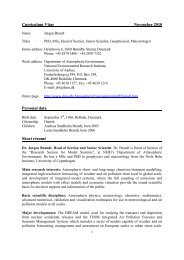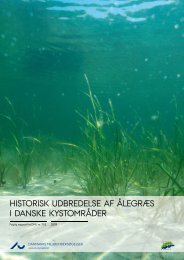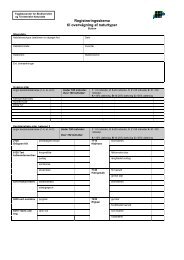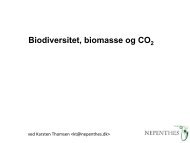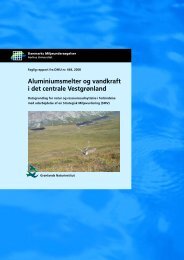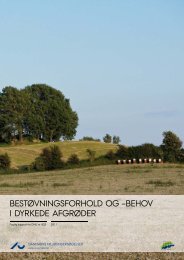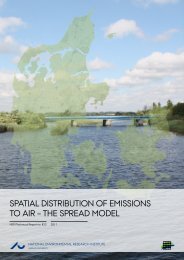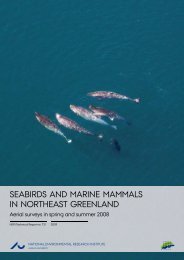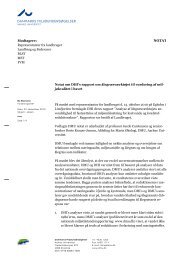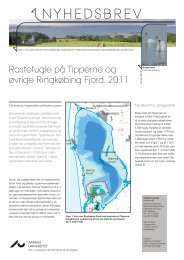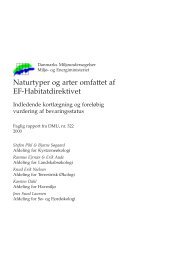DANISH EMISSION INVENTORIES FOR ROAD TRANSPORT ...
DANISH EMISSION INVENTORIES FOR ROAD TRANSPORT ...
DANISH EMISSION INVENTORIES FOR ROAD TRANSPORT ...
Create successful ePaper yourself
Turn your PDF publications into a flip-book with our unique Google optimized e-Paper software.
ook. For previous years the background data consist of LTO/aircraft type<br />
statistics from Copenhagen Airport and total LTO numbers from the Danish<br />
Transport Authority. With appropriate assumptions a consistent time-series<br />
of emissions is produced back to 1985 using also the findings from a Danish<br />
city-pair emission inventory in 1998 (Winther, 2001b).<br />
National sea transport is split into regional ferries, small ferries, freight<br />
transport between Denmark and Greenland/Faroe Islands, and other national<br />
sea transport. For regional ferries, the fuel consumption and emissions<br />
are calculated as a product of number of round trips, sailing time per round<br />
trip, engine size, engine load factor and fuel consumption/emission factor.<br />
For small ferries, freight transport between Denmark and Greenland/Faroe<br />
Islands, and other national sea transport, the calculations are simply fuel<br />
based using the fuel consumption findings from Danish surveys in combination<br />
with average fuel related emission factors.<br />
Non-road working machines and equipment, and recreational craft are<br />
grouped in the following sectors: Agriculture, Forestry, Industry, Household/Gardening,<br />
Commercial/Institutional and Inland Waterways. In general<br />
the emissions are calculated by combining information on the number of<br />
different machine types and their respective load factors, engine sizes, annual<br />
working hours and emission factors.<br />
For military, railways and fisheries the emissions are calculated as the product<br />
of fuel use and emission factors.<br />
Fuel sales data are obtained from the Danish energy statistics provided by<br />
the Danish Energy Agency (DEA). For road transport and aviation the emission<br />
results are adjusted in a fuel balance to ensure that all statistical fuel<br />
sold is accounted for in the calculations. For national sea transport, the fuel<br />
consumption of heavy oil and gas oil is calculated directly by DCE. Fuel adjustments<br />
are made in the fishery sector (gas oil) and stationary industry<br />
sources (heavy fuel oil) in order to maintain the grand national energy balance.<br />
In order to comply with the IPCC guidelines the fuel consumption by<br />
vessels between Denmark and Greenland/Faroe Islands are subtracted from<br />
the DEA fuel sales figures for international sea transport, and added to the<br />
national part of the emission inventories.<br />
Emissions from road transport<br />
Set in relation to the Danish national emission totals, the largest emission<br />
shares for road transport are noted for NOX, CO, CO2, NMVOC, TSP, PM2.5<br />
and PM10. In 2010 the emission percentages were 34, 27, 26, 15, 10, 10 and 9,<br />
respectively. The emissions of NH3, N2O, CH4 and SO2 have marginal shares<br />
of 1.9, 2.0, 0.2 and 0.5 %, respectively.<br />
From 1990 to 2010 the calculated emission changes for CO2 (and fuel use),<br />
CH4 and N2O are 30, -74 and 29 %. For NOX, NMVOC, CO and particulates<br />
(exhaust only: Size is below PM2.5), the 1985-2010 emission changes are -52, -<br />
84, -81, and -65 %.<br />
The most significant emission changes from 1985 to 2010 occur for SO2 and<br />
NH3. For SO2 the emission drop is 99 % (due to reduced sulphur content in<br />
the diesel fuel), whereas the NH3 emissions increase by 2232 % (due to the<br />
introduction of catalyst cars).<br />
7




